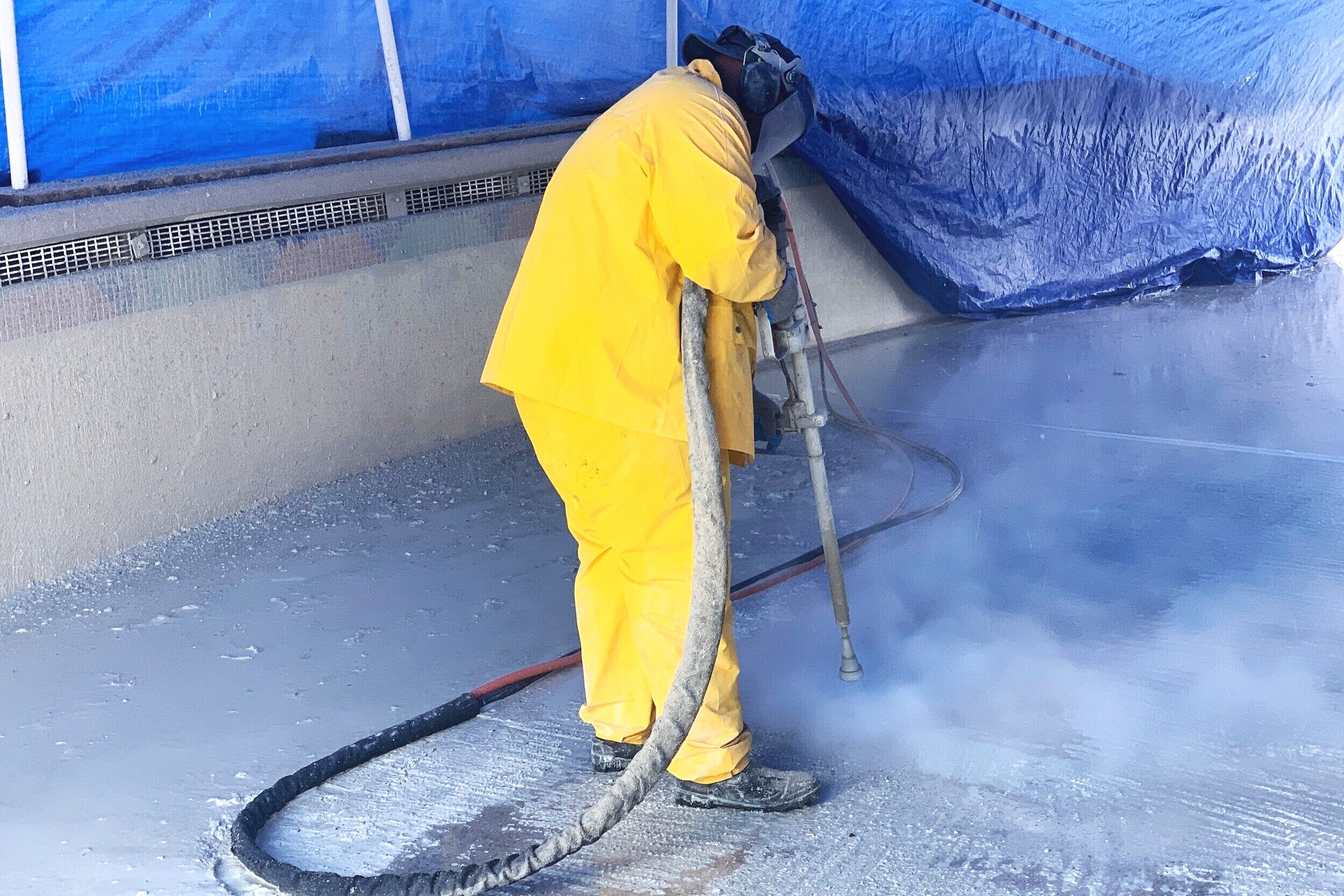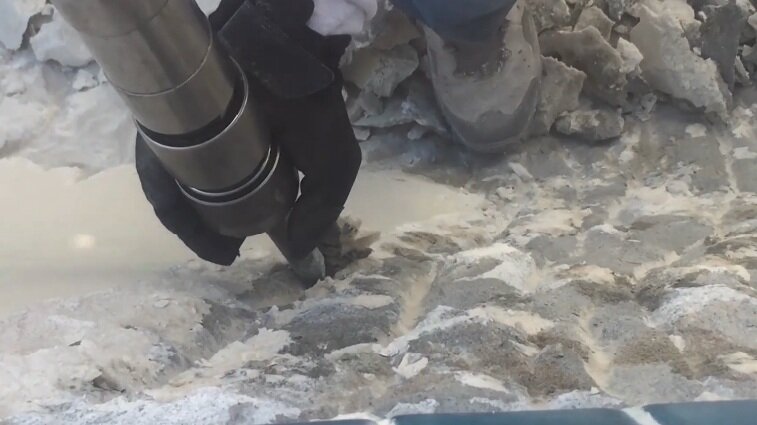
Using the most
advanced, proven
surface preparation
method in the
pool industry.
When resurfacing an existing swimming pool, the importance of surface preparation cannot be overstated.
Research has demonstrated that bond strength between the old and new surface is directly related to surface preparation. Bond is a critical factor in determining the overall performance, durability and longevity of the new pool surface. The goal in surface preparation is to create a sound, clean, rough and consistent surface free of bond inhibiting materials.
Traditionally there have been a number of surface preparation techniques that have been utilized in the swimming pool industry with varying degrees of success. Advancements have been developed and proven in recent years that significantly increase bond strength and significantly improved performance, durability and longevity, which translates to a better resurface investment.
That being the case, many contractors still continue to use the traditional methods for a number of reasons:
It is how they’ve always performed the work.
The advanced methods require significant investments in specialized equipment and training.
Many pool owners don’t consider, or are unaware of the differences between, different surface prep methods
Material bonding often fails 1-3 years after the work is completed and is not warranted by many contractors; contractors typically market the pool finish manufacturer’s warranty, which does not cover material bonding to the pool surface
Our Surface Preparation Process:
Ultra-High Pressure (UHP)
Water Blasting
Classic Pool Plastering performs its swimming pool resurfacing work using the best method available, Ultra-High Pressure (UHP) Water Blasting. All of the existing pool plaster is removed with water blasted at pressures up to 40,000 PSI to create the best surface profile possible for new plaster to adhere to. Classic does not utilize this process because it is easier or cheaper for the company. Classic uses this process because it is the method that produces the highest-quality, longest-lasting replaster investment for our customers.
Classic Pool Plastering offers a 7-year bond warranty on every pool surface we install when using our process. Classic Pool Plastering is able to offer this warranty with confidence. No other company can offer this same guarantee using inferior methods. UHP water blasting surface preparation results in bond values up to 50% stronger than more invasive methods. Additionally, plaster removal using UHP water blasting can be done over and over without the harmful effects of traditional stripping.
UHP water jetting also allows us to forgo the use of acid and bond coat in our surface prep process with superior results. Acid wash and bond coats are completely unnecessary. We also do not need to sandblast paint in instances where pools have been painted prior to prepping our pools.
UHP water blasting also eliminates delays due to weather concerns. With a bond coat, plaster companies need to be concerned with potential rain falling and washing out their bond coat and with cold temperatures during the winter. If the temperatures fall below freezing during the night, it can crystallize the moisture still in the bond coat and cause it to fail
The “Traditional” Surface Preparation Methods:
Chip Out
Air Hammers and Chisels are used to chip away the existing pool surface. This method is time consuming and creates a very inconsistent surface for replastering. Additionally, the use of air hammers and chisels (especially pointed chisels) is harmful to the pool structure. Every time a chipping process is used, some of the structural gunite/shotcrete is removed, thus, the strength of the pool is reduced. Micro-cracking in the pool structure most often results. In addition, the thickness of concrete over the pool reinforcing steel is reduced often exposing the steel to water. This can lead to the development of rust stains in the pool. Lastly, if chipping is performed on the pool multiple times for resurfacing, this process may require major pool reconstruction. It is difficult (nearly impossible) to know how many times a pool has been replastered if you are not the original pool owner.
Bond Coat
Some consider it old-fashioned to perform full chip-outs. Decades ago, when the idea of refinishing pools started, chipping and removing the entire surface was only natural. But it’s grueling work, so when bond coats became available, many pool plasterers and renovators jumped at it.
A common method used by contractors is the use of a bond coat to adhere the new plaster to the old plaster. The Bond Coat method can be problematic based on the existing pool surface, the type of bond coat used, the level of inspection performed by the contractor on the existing pool surface prior to applying the bond coat, and the extend to which the bond coat is used (e.g., the entire pool surface or only in areas where this technique is required and recommended),
Resurfacing a pool does not mean to layer plaster layer, upon plaster layer, upon plaster layer. If a contractor replasters your pool without first removing the previous plaster layer(s) prior to the surface prep process, your pool resurfacing investment will not last long. If a pool that is going to be replastered has more than one layer of plaster, the outer layers must be completely removed. Anything less than this is a bad practice that can lead to failure. Resurfacing work should only be performed on the original plaster layer.
There are two main types of bond coats used: Manufactured and Homebrews. Manufactured bond coats (such as Multicoat, CLI, or SGM) designed for underwater use, are "acceptable" if the pool has never been replastered and the existing plaster is solid. Manufactured bond coats should not be used over multiple layers of plaster without first stripping the layers of plaster off the pool to find a solid, non-hollow surface. The applicator must follow the manufacturers' directions. Manufactured bond coats are only as good as the individuals installing the material.
Glue bond coats (“Homebrews”) are widely used by contractors. It is simply glue with other components added to it, creating a product that is not designed for underwater use. It is used by those companies to save money at the pool owner’s expense. Contractors will never guarantee the bond to last; they just hope it will survive for one year or longer.
Newly applied plaster is semi-permeable until the finish has hydrated enough to close the pores in the finish. Until the pores close, some water will be allowed to reach the back of the plaster and ultimately the bond coat. Water that reaches the back of the plaster will re-emulsify the homebrew and eliminate any bond that may have existed between the plaster and the homebrew bond coat. Once this happens it places the plaster at risk and can cause the plaster to develop hollow spots or “pop-offs”. Once your replaster investment begins to debond you are now faced with a patch repair that will not match the existing plaster. The only way to correct the broken hollow spot and ensure the repair matches is to completely replaster your pool again.
Some contractors will put a bond coat over your existing plaster without performing a quality check of the existing shell to determine if the existing plaster is loose/hollow. It is common for water to remain between layers of plaster in a pool when it is first drained. If you check a pool for hollow spots before allowing that water to leak out of the plaster layers and into the pool, the sound check for hollows will likely not reveal any hollow spots. This will cause the pool to be prepped over loose plaster, resulting in a premature failing of the plaster finish.
Classic Pool Plastering is always asked how long a plaster finish will last, but is never asked how long the bond of the finish will adhere to the substrate. That question is the most important question when you consider the increased number of types of plaster that are on the market designed to last longer than traditional plaster. If the plaster company does not perform a quality check of the existing shell, the finish will not last the 7-10 years that the plaster manufacture warrants the finish. The resulting bond failure is not a warrantable issue for the plaster manufacture. The plaster company that used a bond coat will not stand behind the failure because they did not warrant the bond of the finish at all.
Abrasive Blast
Because of the problems with Chipping and Bond Coats, some companies have chosen to use sand-blasters to etch the existing surface, making it rough enough for bonding but smoother than if it were chipped out.
This method is similar to the sand blast, only cleaner. After water blasting a surface, crews use a power washer to blow splatter and debris back into the pool, acid wash the vessel, and pump everything out. “You’re not shoveling out sand, wheelbarrowing it out or hauling it off to a dump,” says Dave Schilli, president of St. Louis-based Schilli Plastering Co. Inc.
The pressure also will blow out the delaminated or hollow areas.
Some professionals believe the surface etching is enough to properly bond to the new coat of material, while others will add a bond coat.





